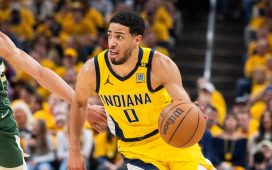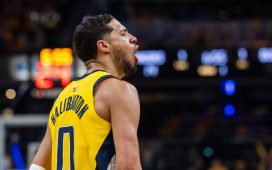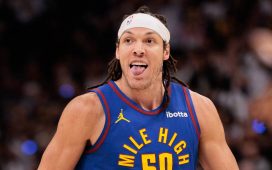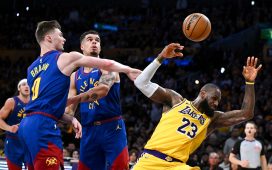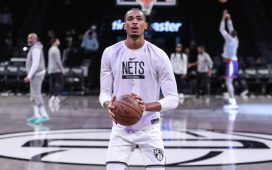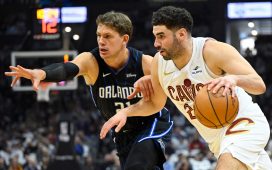As has often been the case this season, an untimely injury disrupted the Los Angeles Lakers’ best-laid plans.
Their season was teetering as January turned into February. They had just suffered back-to-back losses to the Houston Rockets and Atlanta Hawks in the middle of a six-game Grammy Awards-induced road trip, prompting LeBron James to publish his now-infamous hourglass emoji tweet.
Coach Darvin Ham and the rest of the Lakers’ organization knew it was time for another starting lineup change. He had already tinkered with it multiple times, sending guards D’Angelo Russell and Austin Reaves to the bench at different points in search of more defensive balance. Now, both were starting again, but things still weren’t working.
This time, Ham, inspired by a recent double-overtime win against the Golden State Warriors, decided to reach back into his recent past. With a pivotal game against high-scoring Boston Celtics wings Jayson Tatum and Jaylen Brown looming, Ham planned to insert Jarred Vanderbilt into the starting lineup in place of Taurean Prince and reunite the five-man unit that powered the Lakers’ post-trade deadline surge last season, according to team sources not authorized to speak publicly on the matter.
But injuries to LA’s stars sidetracked the plan. Both James (left ankle soreness) and Davis (bilateral Achilles tendinopathy and left hip spasms) were ruled out after shootaround ahead of the Celtics game. Vanderbilt returned to the starting group but as an injury replacement.
Then, just before completing one of his best halves as a Laker, he landed awkwardly and injured his right foot. He has not played since and may not return at all. On Feb. 5, the Lakers said Vanderbilt would be re-evaluated in approximately three to four weeks. More than six weeks later, the only official update was Ham saying Wednesday that the team had not yet ruled out Vanderbilt’s return.
Without Vanderbilt, and with so many nagging injuries to other rotation players, the Lakers shifted to the only alternate plan they hadn’t yet tried this season: Starting Rui Hachimura in place of Prince and reforming the group that so often closed games in last season’s playoffs. To that point, Hachimura had only logged 140 minutes next to Davis and James this season, compared to Prince’s 785.
It has paid immediate dividends. The Lakers won their next game on the road against the red-hot New York Knicks and have slowly begun to salvage their season. The team is now 11-4 with Hachimura as the fifth starter alongside Russell, Reaves, James and Anthony Davis, not including Saturday’s loss to Golden State in which Davis left with an eye injury after the first quarter. Ham immediately noted how the larger starting frontline “created a nice sense of balance.”
“We’re just very big,” James said on Feb. 5 of the new starting lineup. “We have a lot of length, a lot of athleticism. Rui works well with us.”
The unit’s success, at least compared to other Laker starting groups this season, begs a question many Lakers fans — and even some inside the organization — have asked all season. If these groups were so successful in last season’s surprise run to the Western Conference finals, why’d it take so long to go back to them?
“I’ve been telling them, like, this is who we are,” Hachimura said on Feb. 14. “We’ve been trying a lot of different things, some lineups and all this stuff, but this is the lineup we had in the playoffs and that’s how we won, so it’s simple. … It’s just that we know, we’re just really comfortable playing each other.”
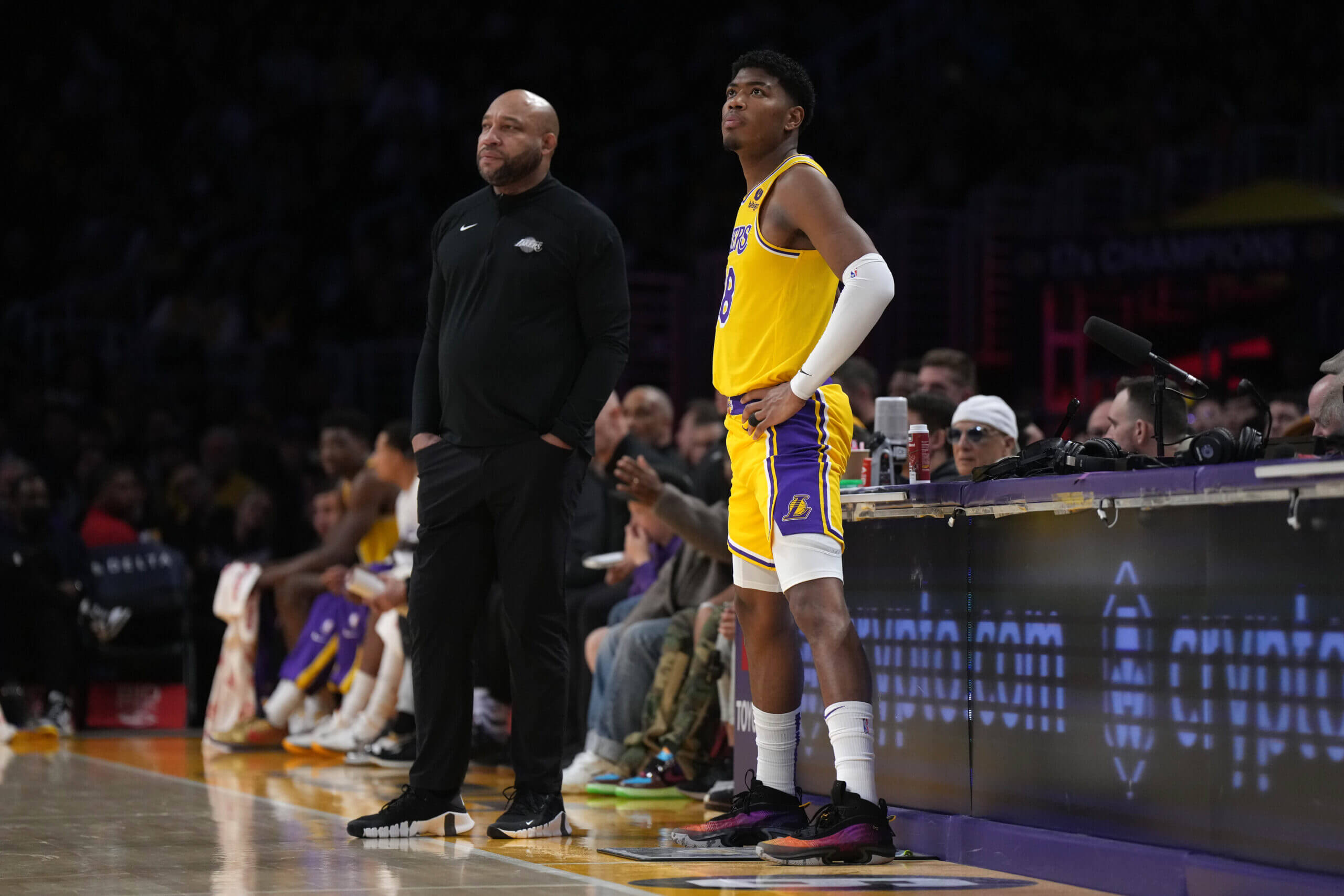
Rui Hachimura, right, said he believes the team’s new starting group with him as the fifth player is “who we are.” But it took Darvin Ham, left, longer to agree. Kirby Lee / USA Today
The buzzword of the Lakers’ 2023 offseason was continuity. The organization’s goal was to retain the core group of James, Davis, Reaves, Russell, Hachimura and Vanderbilt that led them to the Western Conference finals, then use their remaining resources to bolster their supporting cast. Free agent signees Gabe Vincent, Prince, Christian Wood, Jaxson Hayes and Cam Reddish were brought in to supplement the core and help alleviate its weaknesses (3-point shooting, perimeter defense and more useful size).
Almost immediately, things didn’t go as planned.
The team’s open competition for the final starting lineup spot soon devolved when Vanderbilt, the incumbent and favorite to reclaim his spot, hurt his heel in the preseason. He missed the first 20 games of the season and looked rusty upon his return before getting hurt again.
Vanderbilt’s absence has become the what-if of the Lakers’ season. There is no other player on the roster who can approximate his skill set as a versatile, athletic point-of-attack defender who also crashes the glass. His shooting limitations are concerns in a playoff setting, but in the regular season, he’s one of the Lakers’ most important and indispensable players. Teammates in recent press conferences have acted as if Vanderbilt’s return is inevitable.
“Vando is going to come back and the defense is going to be better,” Hachimura said on March 15. “So we just got to keep building.”
“I think we’re starting to find the right lineups,” Davis said on March 10. “Obviously, that can change when Vando comes back. He’s a big part of our defense and what we do.”
With Vanderbilt sidelined, the coaching staff had to choose between Hachimura, who received a new three-year, $51 million contract on the back of his strong 2023 postseason, and Prince, the more natural small forward on a one-year, $4.5 million deal to play for his fifth team in eight NBA seasons. Over the summer, Hachimura, at the behest of the coaching staff, had visibly slimmed down to prepare for more wing minutes.
But once Hachimura arrived in training camp, he didn’t embrace the role-player duties the coaching staff wanted from him — being fully engaged defensively, boxing out hard, making the extra pass. Prince, on the other hand, earned the trust of the coaching staff with his professionalism and consistency.
The decision to start Prince was far from a unanimous one inside the organization. The coaching staff believed Hachimura’s score-first mentality, which had not evolved enough in training camp in their eyes, made him a better fit off the bench. Prince, meanwhile, profiled as the low-usage, 3-and-D player the starting lineup needed to space the floor and slot onto elite wing scorers.
“(Prince is) a bona fide proven shooter/scorer (who) plays with a lot of tenacity,” Ham said ahead of the team’s Oct. 26 home opener against the Phoenix Suns. “Also able to guard multiple positions.”
Prince also had a previous tie to Ham, who served as an assistant coach in Atlanta from 2016 to 2018, when Prince was just beginning his career. That, along with his approach and play to begin the season, helps explain why Prince kept his starting spot for so long even as the new lineup faltered.
When the Lakers tried to problem-solve their league-worst slow starts earlier in the season, Ham first benched Reaves, then Russell, decisions that shocked many inside and outside the building. While the team’s two most prominent guards took turns coming off the bench, Prince remained a starter and Reddish, a minimum contract signing, was promoted. At one point in late December, Reaves, Russell and Hachimura — the team’s third-, fourth- and fifth-highest-paid players — were all coming off the bench while Prince, Reddish and Vanderbilt started alongside James and Davis.
The team’s lineups and playing rotation became the heart of a growing disconnect between the players and the coaching staff. Players from last season’s team fondly referenced last season’s units with either Vanderbilt or Hachimura alongside James, Davis, Reaves and Russell. But with Vanderbilt not at 100 percent, other nagging injuries to key rotation players piling up and the coaching staff still reluctant to start Hachimura, the Lakers persisted with Prince as a starter into January.
By the time of the hourglass emoji tweet, even the coaching staff had to concede that Prince’s defensive-minded skill set was more theoretical than real. The Core 4 + Prince lineup had been outscored by 10 points in their 228 minutes through Jan. 31, a subpar mark for a starting unit. Overall, Prince has a team-worst mark of minus-134 despite playing almost half of his minutes next to both James and Davis. The team has performed worse with Prince playing next to the team’s two stars (-73 in 785 minutes) than with Hachimura (plus-13 in 140 minutes) or Vanderbilt (plus-19 in 154 minutes).
“Taurean, he has to do it on both sides of the ball,” Ham said after moving Prince to the bench. “I just felt like him coming off the bench just would allow him to not only shore up our bench in terms of a defensive presence, but also allow him to get some buckets too. We need him to score and be aggressive offensively.”
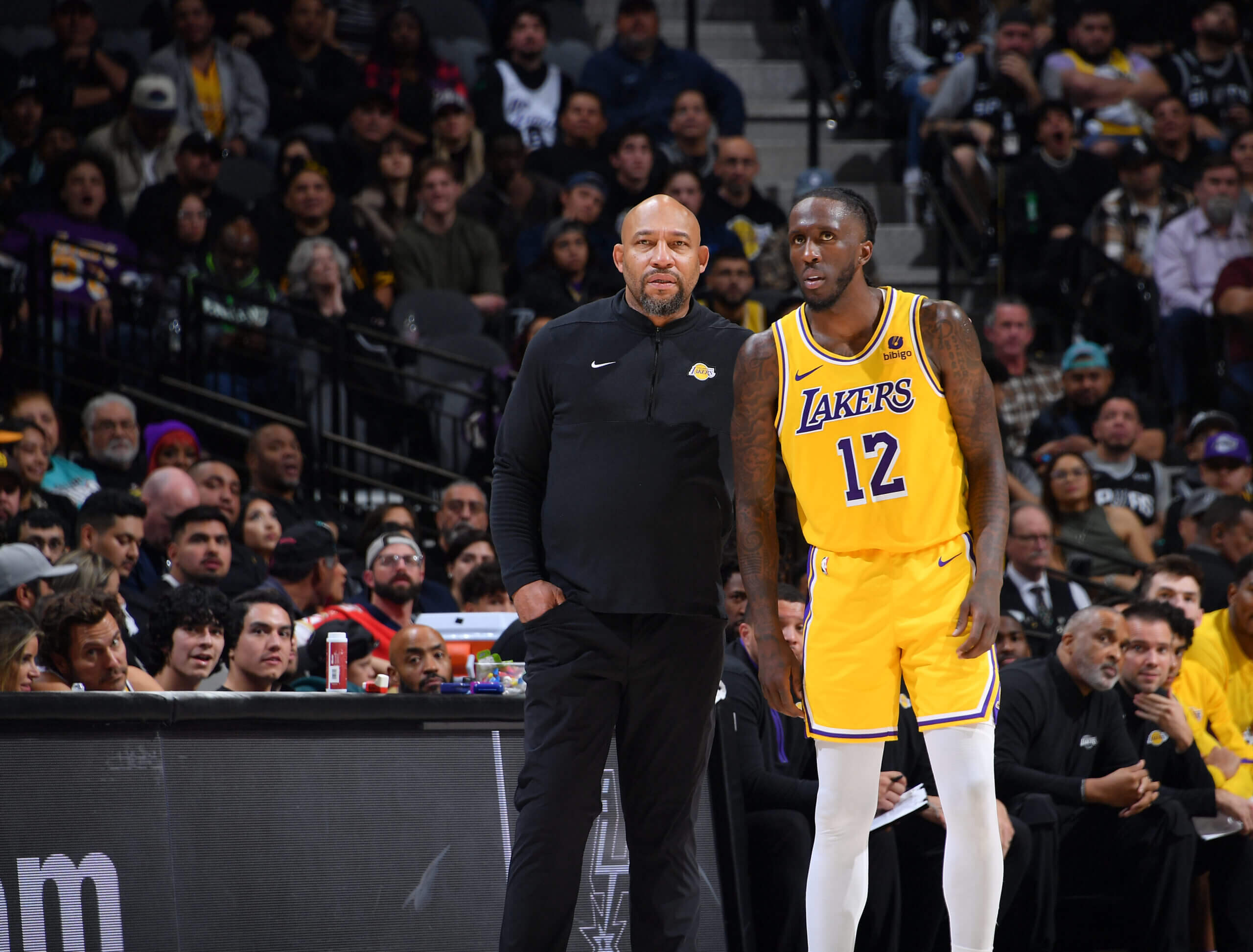
Darvin Ham stuck with Taurean Prince in the Lakers’ starting lineup for more than half the season before moving him to the bench. (Michael Gonzales / NBAE via Getty Images)
With Vanderbilt injured again, Hachimura got his chance to prove last season was no fluke. Ham said the Lakers planned to use this starting lineup for the foreseeable future. So far, the coach has stuck by that claim.
“As you guys can see I think it’s more fluid, it’s more smooth,” Hachimura said. “This is a lineup that we literally did in the playoffs last year, so we’ve been trying to keep building it. But through the lineup change and the injuries, we really haven’t played together. But now, finally, we started playing together for six weeks and we started clicking again.”
The new starting group has outscored opponents by 42 points in 260 minutes. They have a plus-8.0 net differential, per Cleaning The Glass, with an offense in the 64th percentile and a defense in the 57th percentile (as of March 20). It’s the Lakers’ most effective lineup that has logged more than 175 non-garbage time possessions this season.
The team’s offense has taken off in that span. With Hachimura, a capable interior scorer who punishes smaller defenders, the Lakers start five players with three-level scoring capabilities. They were the first starting group to each score at least 20 points in a game since 1993.
“The bigger guys are probably going to be on me and LeBron, and there’s usually a good defender, who’s usually a bigger guy, on D-Lo and (Reaves). So Rui is usually left with a smaller guy,” Davis said. “We try to take advantage of that and have him post up, duck in, or (get the ball) off the glass and kinda get him going.”
The obvious limitation with the new starting group — and the main reason the Lakers’ coaching staff was reluctant to deploy it — is defense, particularly on the perimeter. James’ effort and focus can wane at his age. Russell is historically a minus defender, though he has a knack for getting deflections and poking dribbles loose. Reaves has been targeted by strong, athletic guards and wings all season, though he’s embraced and fared well in difficult matchups against the likes of Stephen Curry, Shai Gilgeous-Alexander and De’Aaron Fox since the All-Star break. Davis remains an elite interior defender, but it’s asking a lot for him to cover up so many holes.
Hachimura, then, is vital to the group’s defensive viability. Unlike Vanderbilt or Prince, Hachimura does not have the look of a typical NBA wing-stopper. He is a stout post defender who can struggle against quicker, more athletic matchups. But his teammates have seen him take on tough assignments before and believe he is capable of doing the job consistently.
“Sometimes, he guards (Nikola) Jokić. He guarded Giannis (Antetokounmpo) some when I wasn’t on him. (Devin Booker). He guarded (Kevin Durant) before,” Davis said. “So we have a lot of confidence in Rui on the defensive end. He’s shown that he can handle those matchups.”
The Lakers’ topsy-turvy season is still far from resolved. Though James (nine missed games), Davis (four), Reaves (zero) and Russell (five) has been largely healthy, the team is still feeling the effects of the surrounding cast’s fluctuating availability. Vanderbilt, Vincent, Wood and Reddish are currently out. Wood is expected to miss the rest of the regular season; there’s a chance he’ll return for Play-In game(s) or the playoffs if the Lakers get there, according to team sources.
There is less clarity with Vanderbilt and Vincent. Neither has been ruled out for the rest of the season, but of the two, there is more internal optimism that Vanderbilt will return before the regular season ends next month, according to team and league sources. If either or both players had been healthy, they may have altered the direction of the Lakers’ season.
But at this point, if the Lakers want to make something of their season, they must maximize the strengths of their current starters and accept their weaknesses. All five players are averaging at least 30.8 minutes since the starting lineup was formed, and that average will likely increase in whatever form of the postseason the Lakers reach.
That means the Lakers’ coaching staff will have to lean on Hachimura more than they initially expected. For better or worse, how he fares could decide the length of the Lakers’ postseason run.
“He is (the X factor),” James said. “He’s been exceptional ever since he got put into the starting lineup. When he plays well, we play well.”
(Top photo: Kiyoshi Mio / USA Today)
